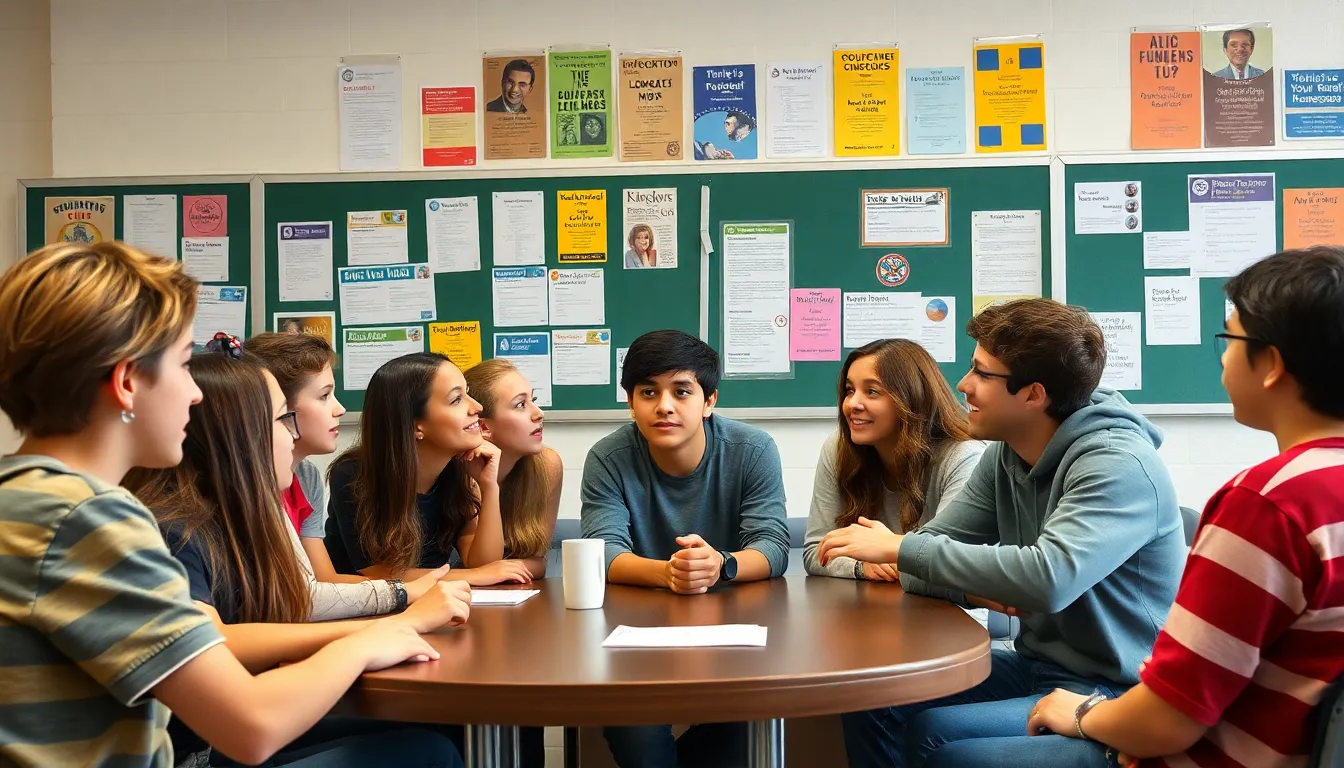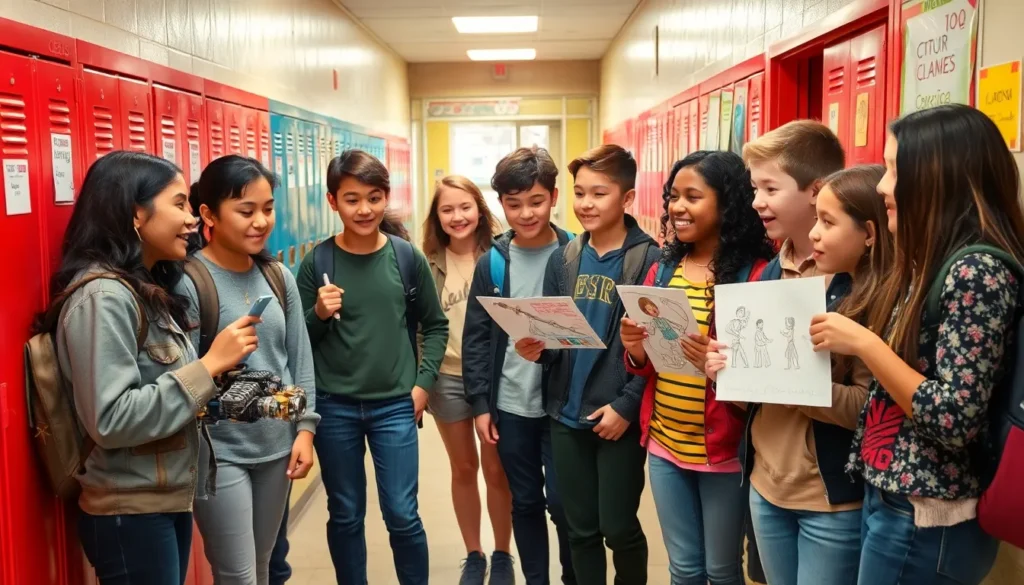Table of Contents
ToggleHigh school isn’t just about cramming for exams and mastering the art of the perfect locker combination. It’s a vibrant playground where students can explore passions, discover talents, and maybe even find their future career path—all while dodging the cafeteria mystery meat. Extracurricular activities offer a chance to step out of the classroom and into a world of creativity, teamwork, and fun.
From drama club to robotics team, these activities are more than just a way to fill a resume. They’re opportunities to build friendships, develop leadership skills, and learn what it means to be part of something bigger than oneself. So whether it’s scoring the winning goal or nailing that solo, high school extracurriculars can turn the chaos of adolescence into an unforgettable adventure. Let’s dive into the world of after-school activities and discover why they’re essential for every student’s journey.
Overview of High School Extracurriculars
High school extracurriculars play a vital role in students’ lives, extending beyond the classroom. These activities provide avenues for personal growth, social interaction, and the development of skills applicable in future endeavors. Participation in clubs, sports teams, and arts programs cultivates interests that might lead to lifelong passions or career opportunities.
Various options exist for students. Academic clubs like debate and science Olympiad challenge critical thinking and analytical skills. Through sports teams such as soccer, basketball, and track, students learn about teamwork, discipline, and competition. Arts programs including choir, theater, and visual arts offer creative outlets, allowing for expression and innovation.
Student government promotes civic engagement, leadership, and organizational skills. Volunteering opportunities enable students to contribute to their communities while fostering empathy and social responsibility. Each extracurricular activity cultivates unique experiences that enhance high school education.
Moreover, students can develop friendships and build networks that last beyond graduation. Connections made in drama club or on the robotics team often create support systems that benefit individuals throughout their lives. Choosing to engage in these activities transforms the high school experience, making it richer and more fulfilling.
Participation in extracurriculars not only enhances academic performance but also leads to improved mental health. Studies link involvement in these activities with increased self-esteem and lower levels of stress. Engaging in diverse interests prepares students for the multifaceted challenges of the future.
Benefits of High School Extracurriculars

High school extracurriculars provide valuable benefits that extend beyond academics. Participation in these activities fosters significant personal and social growth.
Personal Development
Personal development thrives in extracurricular environments. Students gain essential skills such as time management and goal setting. Commitment to a sport or club often enhances resilience. Overcoming challenges strengthens self-confidence. Exploration of new subjects or interests encourages creativity. Participation in student-led initiatives cultivates leadership abilities. Exposure to various situations prepares students for future challenges. Developing these attributes can lead to improved academic performance and personal satisfaction.
Social Skills
Social skills flourish through interaction in extracurriculars. Students collaborate with peers on projects, fostering teamwork. Conflict resolution becomes easier through navigating group dynamics. Forming friendships gives a sense of belonging and community. Networking with diverse individuals expands social circles. Effective communication is often practiced in presentations or public speaking events. These interactions create a supportive environment that nurtures interpersonal skills. Students build relationships that often last beyond high school, enriching their social lives.
Types of High School Extracurriculars
High school students engage in various extracurricular activities that cater to diverse interests. These activities enhance their overall experience and development.
Sports and Athletics
Sports teams offer students opportunities to develop physical skills and teamwork. Participation fosters discipline and dedication, essential traits for success. Competitive environments often build resilience and improve mental health among participants. Many schools provide a range of options, including soccer, basketball, and swimming teams. Engaging in sports also helps students forge strong friendships while promoting school spirit and camaraderie.
Arts and Music Programs
Arts and music programs nurture creativity in students, allowing expression through various mediums. Students can explore visual arts, theater, and different musical instruments within these programs. Participating in drama clubs or orchestra teaches collaboration and enhances public speaking skills. These programs often lead to performances, showcasing students’ talents to the school community. Involvement in arts fosters appreciation for culture and boosts confidence in personal abilities.
Academic Clubs
Academic clubs focus on specific subjects, offering intellectually stimulating environments. Students can join clubs centered around math, science, or debate, encouraging critical thinking and collaboration. Membership enhances knowledge in particular fields while fostering a sense of community among peers. Competitions, such as science fairs or academic decathlons, often arise from these clubs, motivating students to excel. Participation in academic clubs builds skills essential for future educational pursuits and career opportunities.
How to Choose the Right Extracurriculars
Selecting the right extracurriculars involves careful consideration of personal interests and available time.
Assessing Interests and Skills
Identifying passions drives the selection process for meaningful extracurricular involvement. Students can reflect on personal hobbies and subjects that spark excitement as starting points. Exploring options like debate club or music ensembles often reveals hidden talents and unrecognized interests. Engaging with peers or teachers about their experiences provides additional insights into potential activities. Researching various extracurriculars allows students to realize which areas align best with their skills and future goals.
Time Management Considerations
Balancing academic commitments with extracurricular activities is essential. Prioritizing time management skills influences a student’s choice of activities. Planning a weekly schedule helps to visualize how much time each commitment will require. Evaluating existing responsibilities ensures students do not overextend themselves. Students should consider the number of extracurriculars they can realistically handle without compromising academics or personal well-being. Defining specific time slots for participation aids in maintaining a healthy balance throughout the school year.
High school extracurriculars play a pivotal role in shaping a student’s experience. They offer opportunities for personal growth and skill development while fostering social connections. Engaging in these activities not only enhances academic performance but also contributes to overall well-being.
By exploring various interests students can uncover hidden talents and passions that may guide their future paths. Balancing these commitments with academic responsibilities prepares them for the challenges ahead. Ultimately, high school extracurriculars serve as a foundation for lifelong learning and personal fulfillment, making them an essential aspect of the educational journey.







